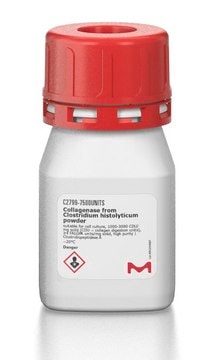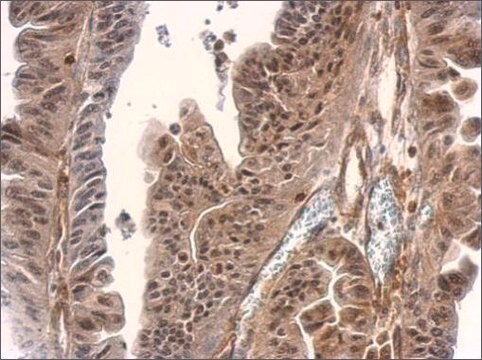C9572
Collagenase from Clostridium histolyticum
lyophilized powder (from 0.2μm filtered solution), suitable for cell culture, high purity
Synonym(s):
Clostridiopeptidase A
Sign Into View Organizational & Contract Pricing
All Photos(1)
About This Item
Recommended Products
biological source
Clostridium histolyticum
form
lyophilized powder (from 0.2μm filtered solution)
mol wt
68-130 kDa
concentration
1 mg/mL
technique(s)
cell culture | mammalian: suitable
shipped in
ambient
storage temp.
−20°C
Looking for similar products? Visit Product Comparison Guide
Application
This product is suitable for the disaggregation of human tumor, mouse kidney, human adult and fetal brain, lung and many other epithelia tissues. It has also been shown to be effective in liver and kidney perfusion studies, digestion of pancreas, isolation of nonparenchymal rat liver cells and hepatocyte preparation. Collagenase has also been used in the preparation of arterial tissue for the study of Advanced Glycosylation End Products. This enzyme has been tested for the release of heptatocytes at a concentration of approximately 1 mg/mL. Concentrations for digestion range from 0.1 to 5 mg/mL.
Biochem/physiol Actions
Collagenase is activated by four gram atom calcium per mole enzyme. It is inhibited by ethylene glycol-bis(beta-aminoethyl ether) - N, N, N′,N′-tetraacetic acid, beta-mercaptoethanol, glutathione, thioglycolic acid and 8-hydroxyquinoline.
The collagenase product is a mixture of enzymes secreted by C. histolyticum, with different products differentiated by the relative ratios of the 10-18 components found in the secreted enzymes. The main components are two collagenases, clostripain, and a neutral protease. The synergistic action of these enzymes degrade collagen and other intracellular materialThe action of both collagenase enzymes and the neutral protease is necessary for effective release of cells from tissue. Various types of collagen are the natural substrates for collagenase.
Caution
As supplied, this product is stable for one year at -20°C. There is no loss in FALGPA or protease activity in 30 days at 37°C, 50°C and -20°C. Solutions of crude collagenase are stable if frozen quickly in aliquots (at 10 mg/mL) and kept frozen at -20°C. Further freeze-thaw cycles will damage the solution. The product retains 100% activity over 7 hours when held on ice.
Unit Definition
One collagen digestion unit (CDU) liberates peptides from collagen from bovine achilles tendon equivalent in ninhydrin color to 1.0 μmole of leucine in 5 hours at pH 7.4 at 37 °C in the presence of calcium ions. One FALGPA hydrolysis unit hydrolyzes 1.0 μmole of furylacryloyl-Leu-Gly-Pro-Ala per min at 25°C. One Neutral Protease unit hydrolyzes casein to produce color equivalent to 1.0 μmole of tyrosine per 5 hr at pH 7.5 at 37°C. One Clostripain Unit hydrolyzes 1.0 μmole of BAEE per min at pH 7.6 at 25°C in the presence of DTT.
Preparation Note
This collagenase is obtained from the culture filtrate of type VII (C2799) Clostridium histolyticum. The culture filtrate is thought to contain at least 7 different proteases ranging in molecular weight from 68-130 kDa. Solutions are typically prepared at 1-2 mg/mL in TESCA buffer (containing 50 mM TES, 0.36 mM Calcium chloride, pH 7.4 at 37°C.
related product
substrate
Product No.
Description
Pricing
Signal Word
Danger
Hazard Statements
Precautionary Statements
Hazard Classifications
Eye Irrit. 2 - Resp. Sens. 1 - Skin Irrit. 2 - STOT SE 3
Target Organs
Respiratory system
Storage Class Code
11 - Combustible Solids
WGK
WGK 1
Flash Point(F)
Not applicable
Flash Point(C)
Not applicable
Personal Protective Equipment
dust mask type N95 (US), Eyeshields, Gloves
Choose from one of the most recent versions:
Already Own This Product?
Find documentation for the products that you have recently purchased in the Document Library.
Gaohai Shao et al.
Journal of inflammation (London, England), 17, 17-17 (2020-05-01)
Ubiquitination-mediated M1/M2 macrophage polarization plays important roles in the pathogenesis of immune disease. However, the regulatory mechanism of ubiquitination during M1/M2 macrophage polarization following intracerebral hemorrhage (ICH) has not been well studied. In the experiment, macrophages were administered with erythrocyte
Farhatullah Syed et al.
PloS one, 7(2), e31430-e31430 (2012-03-03)
Dupuytren's disease (DD) is a benign, fibroproliferative disease of the palmar fascia, with excessive extracellular matrix (ECM) deposition and over-production of cytokines and growth factors, resulting in digital fixed flexion contractures limiting hand function and patient quality of life. Surgical
Fanny Guimont-Desrochers et al.
Journal of immunology (Baltimore, Md. : 1950), 182(9), 5193-5197 (2009-04-22)
The combined phenotypic expression of CD11c(low)B220(+)CD122(+)DX5(+) has been used to define a novel cell type termed IFN-producing killer dendritic cells (IKDC). IKDC readily produce IFN-gamma and demonstrate spontaneous cytotoxic activity toward tumors, suggesting that a modulation of IKDC number may
Martin Gelbard et al.
The Journal of urology, 187(6), 2268-2274 (2012-04-17)
Collagenase Clostridium histolyticum is an investigational nonsurgical treatment for Peyronie disease. In this phase 2b, double-blind, randomized, placebo controlled study we determined the safety and efficacy of collagenase C. histolyticum and assessed a patient reported outcome questionnaire. A total of
Stephen Coleman et al.
BMC musculoskeletal disorders, 13, 61-61 (2012-05-01)
Dupuytren's contracture (DC) is a progressive fibroproliferative disorder characterized by development of nodules and collagen cords within the palmar fascia of the hand. Collagenase clostridium histolyticum (CCH) is currently approved in adults with DC for the nonsurgical treatment of a
Our team of scientists has experience in all areas of research including Life Science, Material Science, Chemical Synthesis, Chromatography, Analytical and many others.
Contact Technical Service





